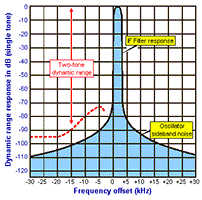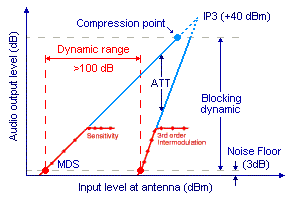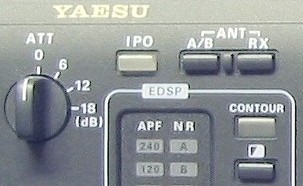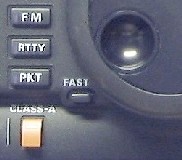|
The
Yaesu FT-1000MP Mark-V transceiver
|

|
|
Selectivity on USB. |
Selectivity,
sensitivity and IMD (IV)
In
term of selectivity and sensitivity, up to date few other brands can
claim to flirt with the high figures of the Mark-V. Its three main
competitors are in ascending order Kenwood TS-2000, Icom IC-756PROIII
and Ten-Tec 565 ORION. We will successively review the selectivity, sensitivity and IMD
characteristics of the Mark-V. These concepts being quite fuzzy for many amateurs,
a short introduction will help you to understand what means
practically each of these terms.
First
the selectivity. This is the ability of a circuit to respond
with a great current amplitude at one desired frequency, and
to discriminate against others. Sharper is the circuit,
stronger is the selectivity and thus the separation of
signals. When applied at the IF stage this characteristics
depends on the quality factor or high-Q of filters used. In
this matter we have seen when we described the EDSP functions
that the selectivity of the Mark-V is exceptional, both using
the analog and digital filtering, even compared to its nearest
competitors. A tune at S9+60 dB can drop as low as the hash of
the background noise !
Then
the sensitivity. It represents the ability of a receiver to
respond to an incoming signal. The highest is the sensitivity,
the more responsive is the receiver to weak signals. In this
matter the Mark-V excels thanks to its many filtering features
installed at all stages of the IF filter chain, mixing analog
and digital means to fight against interferences and other
statics and extract the least signal from the background
noise.
In
practice Yaesu did not list the sensitivity and dynamic range of the
Mark-V so you must make your own measurements to appreciate its
specifications. At 14.2 MHz, preamp off, for a S9 signal the sensitivity
is 99 μV, and 30 μV preamp on. For the squelch, at threshold and
preamp on, the sensitivity is 2.0 μV at 14 MHz in SSB.
|
 |
|
Higher
is the blocking dynamic range (MDS to IP3), better will be the 3d-order
IMD and the sensitivity. |
The
last improved feature concerns the IMD characteristics and dynamic
range. Remind that in a receiver the first stage can be saturated
by two or more stations which signal is particulary strong. In these conditions the
system creates products of intermodulation; in other words signals
do no more exist and are replaced by an unreadable sound. This
occurs quite often on a crowded band like on the 40m. In fact these
products are multiplied among themselves and fall outside the band.
These mixing of frequencies are called intermodulation products of the third order (3d-order IMD).
The intercept point
(IP) is the level at which the amplitude of intermodulation signals
equalizes the desired signals; this point is the famous IP3. The
drawing displayed at left explains this characteristics and
many others better than thousand words. Between the compression
point and the minimum detectable signal level (MDS) we are in the
working zone of the preamplifier and it represents the blocking dynamic
range of the receive module.
On
the Mark-V the MDS, preamp off, is -115 dBm on 1.0 MHz and
-127 dBm between 3.5-14 MHz. Preamp on, these values are
still better with respectively -122 dBm, and -136 dBm to
-135 dBm.
At
last the blocking dynamic range using a 500 Hz filter,
preamp off, is 129 dB between 3.5-14 MHz. Preamp on it is of
128 dB on 3.5 MHz and 126 dB on 14 MHz.
With
the previous sensitivity (about 30 μV at S9 preamp on), in the Mark-V
a two-tone 3d-order IMD reaches 101 dB on 14 MHz where most of its competitors do
even not reach 100 dB, while the IP3 tops out at about +25.7 dBm on 14 MHz for
a S-5 signal preamp off, and +17.3 dBm preamp on. Up to date only the Icom
IC-756PROIII and Ten-Tec 525 ORION reach or exceed such values. Better, IP2 is +68.3
dBm preamp off, +68.5 dBm preamp on, but when the VRF and preamp are
enabled the Mark-V breaks the top with +112 dBm with a noise
floor with VRF that drops to -129 dBm on 14 MHz preamp on. The
result is still better in Class A. No other transceiver
reach such values.
At
last, in FM mode, the rejection of a channel spaced of 20 kHz is 85
dB on 29 MHz, 10 dB better compared to the first "MP" serie,
and the 3d-order IMD is 79 dB, 4 dB better too. In short the Mark-V receive
module will be very hard to beat.
To
read: Learn to play with dB, dBm, dBW, dBi and dBd
HF
preamplifiers
To
increase the dynamic of signals at receive and avoid intermodulation
when too much gain is applied at the entry stage, Yaesu included no
less than three FET preamplifiers in the Mark-V : one
general-purpose "Wide Band" preamp (flat response) and two
"Tuned" units, one optimized for the low bands of 160 to
40m, the other for the upper bands from 12 to 10m. In-between, for
the 20m band, Yaesu suggests to use either the wide or the tuned preamp,
which results are almost equivalent. Outside these bands the wide band
preamp is applied by default.
Each
preamp is automatically applied according the band selected but you
can disable the tuned preamps in changing the settings in the Menu
option 8-4 (FrontEnd) to "Flat".
|

|
|
IPO
stands for Optimization of the Point of Interception. Used
in conjunction with ATT you can practically reduce
intermodulations to the hash. |
Good
news, like with the DSP, when you enable the Wide Band preamp preset on the
upper bands outside an amateur high band (say 25 instead of
24 MHz), the larger gain of the preamp will reduce the
background noise, and conversely on the lower bands. If the
QRM on the lower bands is too strong you can also disable
all HF preamps in pressing on IPO (a LED located above the EDSP
control panel) what increases the dynamic of a ten dB and reduces also
the intermodulation distortion (and somewhat the sensitivity).
In
practice, below 10 MHz the IPO is usually
enabled. In the strange Yaesu logic "disabling
preamps" means that the concerned IPO LED
is lighted (IPO enabled), although the contrary should have been more
logical. But other brands proceed in the same way. Note
that if the interfering signal is so strong that the IPO
cannot completely remove it, you can still use the
ATTenuator to lower the signal to another 6, 12 or even 18
dB more.
Class A operation
If
you want to work in Class A
amplification, famous for its linearity and the quality of its
audio in Hi-Fi systems, Yaesu installed a "Class-A" function,
available at the touch of an orange button located just below at left of
the main VFO tuning knob.

|
Welcome in Class A. |
This is a very interesting
option, mainly if you work on low bands, that was improved since the first
"MP" model. Originally the worst-case 5th-order IMD products was
of -43 dB (on 12m) and reaches now -80 dB (on 20m) on the Mark-V ! In
Class A you take thus also advantage of the superior IMD
characteristics of this class compared to the standard Class AB2
amplification of the Mark-V.
This Class
A mode limits the ouput power to 75 W PEP. The
reason for which Yaesu limited the power (as well as on the
S-meter) in due to the fact that in this mode the high quality of
the signal is paid by the consumption of much energy; the efficiency
of power amplifiers being at best of 50%, implying a high power
dissipation.
Although
the signal excitation is somewhat spoiled in this mode, this
"Hi-Fi" mode can be used to drive a linear amplifier to
preserve the output signal using the system at its nominal power
without risk to damage the amp running it a full power (200 W).
Note
that you can also limit the output power to 10, 75 or 200 W PEP via
the Menu option 4.0 (rF out) as well as during the tune-up procedure
seen previously (Menu Option 4-3 tun-drv).
CW
operations
For
the CW enthusiasts, the Mark-V offers many narrow filters to extract
the weakest signals from the hash. But recall that the filter you
select must match the DSP bandwidth if you want to have some hope to
hear your correspondent...
Like
all modern transceivers, the Mark-V uses equally the straight key or
the paddle. Before using your key you need to enable the KEYER
button (located below the Sub VFO-B) then adjust the speed with the
SPEED control. If you like to work in bug mode, press only the point
lever and if the dash/dot ratio is uncorrect, the Mark-V offers you
the possibility to modify its settings using once more time the
Menu, option 7-1 (kYr-dot) for the dots weight and 7-2 (kYr-dSH) for
dashes weight. By default a dot is as long as the space between two
characters (set to 10/127) and dashes are 3 times longer that dots
(set to 30/127).
The
CW tone frequency can be adjusted between 300 and 1050 Hz by
step of 50 Hz to offer a pleasant audio. This is welcome all
the more than our ears change of sensitivity and response
with age. This is achieved in pressing on SPOT (located near
the keyer button) and turning the PITCH knob on the right
frequency. This latter can be displayed on the secundary
bargraph if you set it via the Menu option 3-5 (PnL-diSP) to
"A1 (CW) Pitch" instead of Clarifier or Offset for
example.
At
last the sidetone level can be adjusted, but one more time
using a control named CW SIDETONE located... on the rear
panel near the KEY plug. It must be turned almost to its
lowest level to get a reasonable volume.
Some
users consider however that in CW the Mark-V response should be
improved. In semi-breaking QSK mode for example, when the default
dropout time is set to 0.00 there are undesired relay-clicking that
we don't notice to its competitors that
force to set the delay to a few milliseconds (say 0.3 ms) via the
Menu option 7-5 (kYr-dLY). There is also a very bad click on
transmission.
If
these problems can be secundary or even without interest for someone
who don't practice CW, so much problems in only one mode, added to
the other ones that we have described, can however incite high-speed CWers and
active contesters to ask a refund of their transceiver or even to give up
definitely their interest for this brand.
Scanning
capabilities
Like
all solid-state transceivers, the Mark-V offers some powerful
scanning capabilities associated to an intensive usage of its
memories. The activation of a scanning on the VFO-A is
straightforward : press on UP or DWN button durant 1/2 sec and the
system begin to scan the band as set in the Menu option 2-4. The
speed (FAST button) of scanning is defined by Meny option 2-3 while
the settings of a specific frequency can be store in several groups
of memory banks depending on the parameters set in Menu option 2-5.
You
can scan all a band, a limited range of frequencies, the memories
containing data on frequencies stored previously, and even skip some
banks that you flagged to avoid for example to be halted each time
that the system encounters a beacon or a WWV signal.
We
will extend a bit longer on memories on page 6 but I suggest to read
the Operating manual to get a full information. Because if it is
easy to store a frequency and recall it later in pressing one or two
buttons, be able to handle all the possibilities of the scanner and
memories request a long training and a serious habit. Up to now I
cannot totally play with them without reading the manual.
Next chapter
Menu
and other settings |